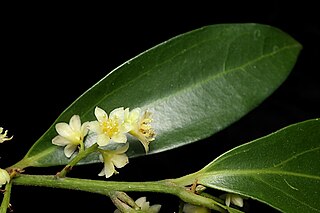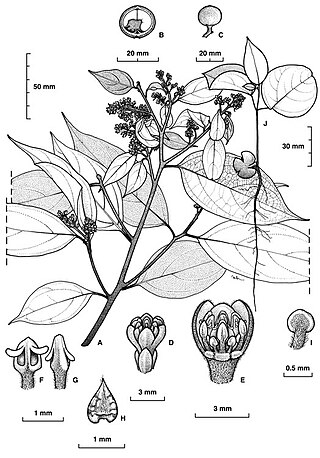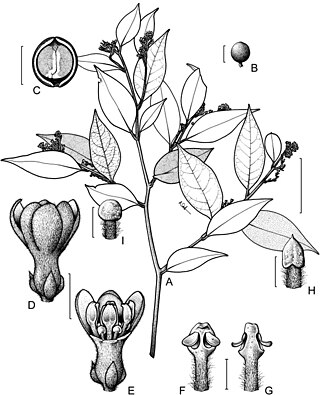
Cryptocarya foetida, commonly known as stinking cryptocarya or stinking laurel, is a species of flowering plant in the family Lauraceae and is endemic to eastern Australia. It is a small to medium-sized tree with egg-shaped to elliptic leaves, cream coloured, unpleasantly perfumed, tube-shaped flowers, and spherical black to purplish drupes.

Cryptocarya microneura, commonly known as murrogun, murrogun laurel or brown jack, is a species of flowering plant in the laurel family and is endemic to eastern Australia. It is a rainforest tree with lance-shaped to elliptic leaves, the flowers cream-coloured and tube-shaped but not perfumed, and the fruit a spherical to elliptic black drupe.

Cryptocarya laevigata, commonly known as red-fruited laurel, glossy laurel or grey sassafras, is a species of flowering plant in the family Lauraceae and is native to Malesia, New Guinea and eastern Australia. It is a shrub or tree with lance-shaped to elliptic leaves, creamy white, pale green and perfumed flowers, and more or less spherical, red to orange-yellow drupes.

.

Cryptocarya bidwillii, commonly known as yellow laurel, is a species of flowering plant in the laurel family and is endemic to eastern Australia. Its leaves are lance-shaped to elliptic, the flowers creamy-white and tube-shaped, and the fruit an elliptic black drupe.

Cryptocarya corrugata, commonly known as corduroy laurel, oak walnut, acidwood or bull's breath, is a species of flowering plant in the laurel family and is endemic to north Queensland. It is a tree with egg-shaped to elliptic leaves, the flowers creamy-green, slightly perfumed and tube-shaped, and the fruit a spherical black to bluish-black drupe.

Cryptocarya angulata, commonly known as ivory laurel, ivory walnut, bull's breath or acidwood, is a tree in the laurel family and is endemic to north Queensland, Australia. Its leaves are lance-shaped to elliptic or egg-shaped, the flowers tube-shaped and creamy-green and the fruit a bluish or black drupe.

Cryptocarya bamagana, commonly known as Bamaga walnut, is a tree in the laurel family and is endemic to Cape York Peninsula. Its leaves are lance-shaped to elliptic or egg-shaped, the flowers cream-coloured and tube-shaped, and the fruit a spherical black drupe.

Cryptocarya bellendenkerana is a tree in the laurel family and is endemic to North Queensland. Its leaves are lance-shaped to egg-shaped, the flowers creamy-green and tube-shaped, and the fruit a spherical black drupe.

Cryptocarya clarksoniana, commonly known as Clarkson's laurel, is a tree in the laurel family and is endemic to north Queensland. Its leaves are lance-shaped to elliptic, the flowers creamy-green and tube-shaped, and the fruit a spherical black drupe.

Cryptocarya cocosoides, commonly known as coconut laurel, is a tree in the laurel family and is endemic to north Queensland. Its leaves are lance-shaped to elliptic, the flowers creamy-green, perfumed and tube-shaped, and the fruit a spherical black to purple drupe.

Cryptocarya dorrigoensis, commonly known as Dorrigo laurel, is a species of flowering plant in the laurel family and is native to northern New South Wales. It is a tree with lance-shaped leaves, the flowers greenish-cream to creamy-yellow but not perfumed, and the fruit is a spherical to elliptic, black to bluish-black drupe.

Cryptocarya exfoliata is a species of flowering plant in the family Lauraceae family and is native to Cape York Peninsula the Northern Territory and New Guinea. Its leaves are lance-shaped, the flowers creamy-green and slightly perfumed, and the fruit is a spherical to elliptic black drupe.

Cryptocarya grandis, commonly known as cinnamon laurel or white laurel, is a tree in the laurel family and is endemic to north Queensland. Its leaves are lance-shaped to elliptic, the flowers creamy-green, unpleasantly perfumed and tube-shaped, and the fruit a spherical drupe.

Cryptocarya hypospodia, commonly known as northern laurel, white walnut, rib fruited pepperberry or north queensland purple laurel, is species of flowering plant in the laurel family and is native to northern Australia and New Guinea. It is a tree with elliptic to egg-shaped leaves, pale brown and creamy-green flowers, and spherical black drupes.

Cryptocarya leucophylla, commonly known as northern laurel, is a species of flowering plant in the family Lauraceae and is endemic to Queensland. It is a tree with elliptic to egg-shaped leaves, creamy green, unpleasantly perfumed flowers, and elliptic to more or less spherical, black drupes.

Cryptocarya lividula, commonly known as blue laurel, is a species of flowering plant in the family Lauraceae and is endemic to north Queensland. It is a tree with lance-shaped to egg-shaped leaves, creamy green, unpleasantly perfumed flowers, and more or less spherical, purplish-black drupes.

Cryptocarya meisneriana, commonly known as northern rivers laurel, thick-leaved cryptocarya, Meisner's laurel or thick-leaved laurel, is a species of flowering plant in the family Lauraceae and is endemic to eastern Australia. It is a tree or shrub with lance-shaped leaves, creamy and pale green, perfumed flowers, and elliptic to oval black drupes.

Cryptocarya melanocarpa is a species of flowering plant in the family Lauraceae and is endemic to north Queensland. It is a tree with elliptic to oblong to lance-shaped leaves, creamy green, unpleasantly perfumed flowers, and spherical black drupes.

Cryptocarya oblata, commonly known as the bolly silkwood, silkwood, bolly, tarzali or tarzali silkwood, is a species of flowering plant in the family Lauraceae and is endemic to north-eastern Queensland. It is a tree with lance-shaped to elliptic leaves, creamy green, perfumed flowers, and flattened spherical to pear-shaped, red to orange drupes.




















